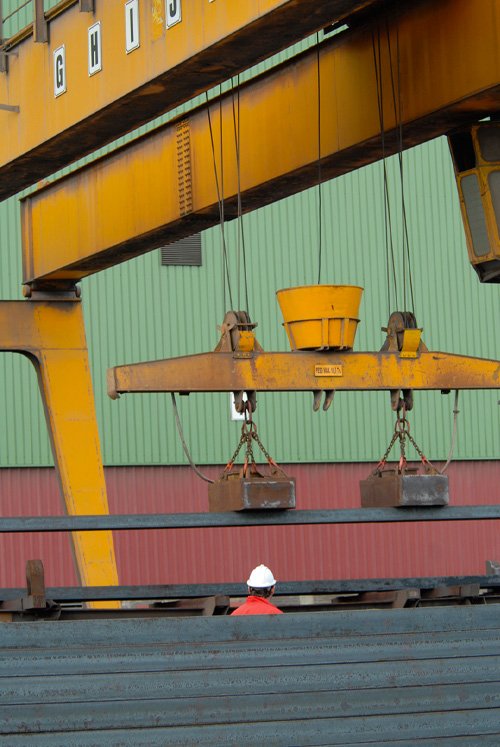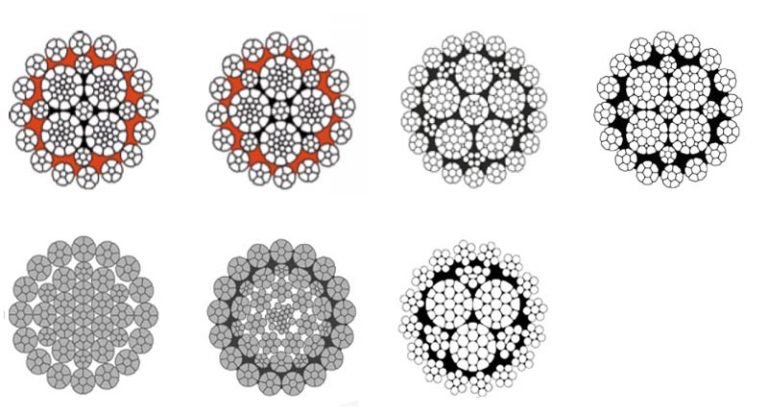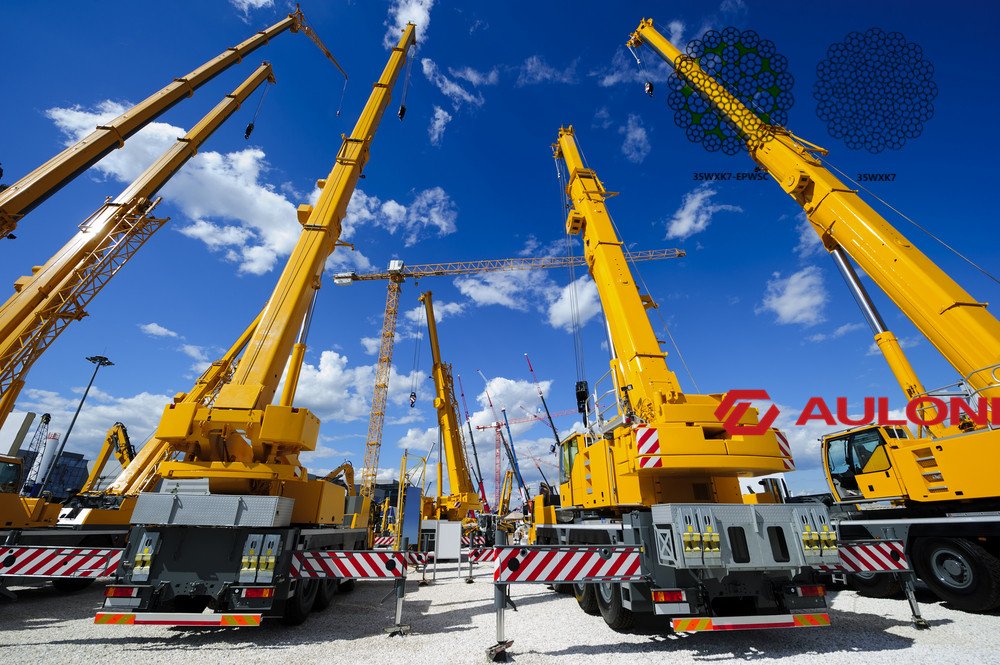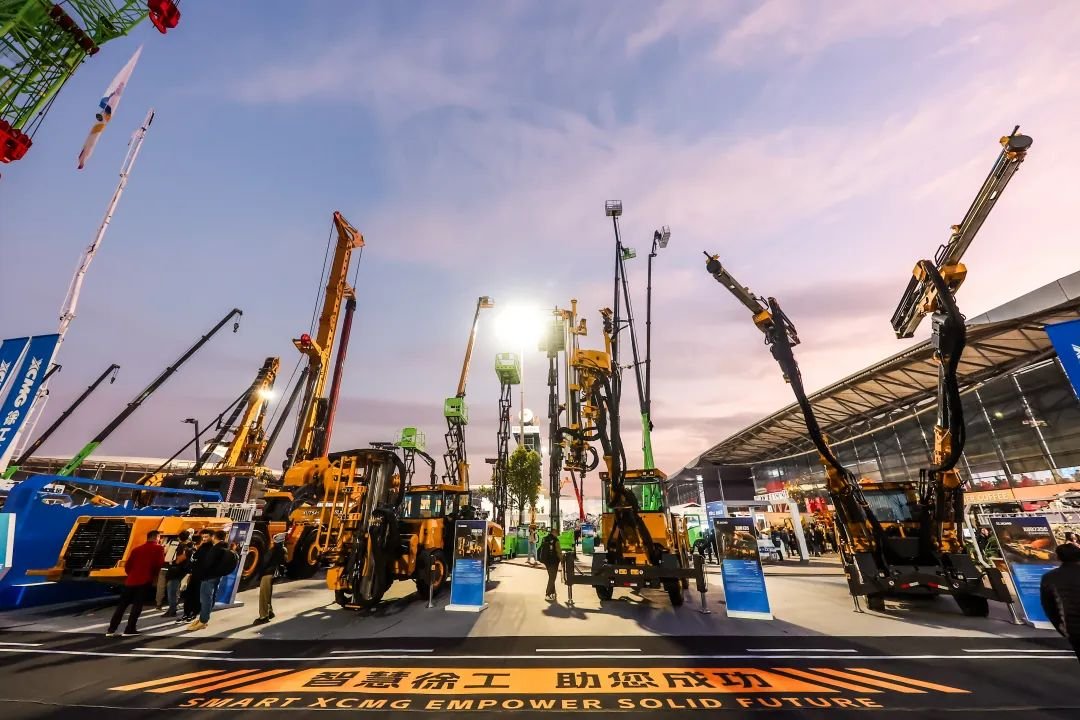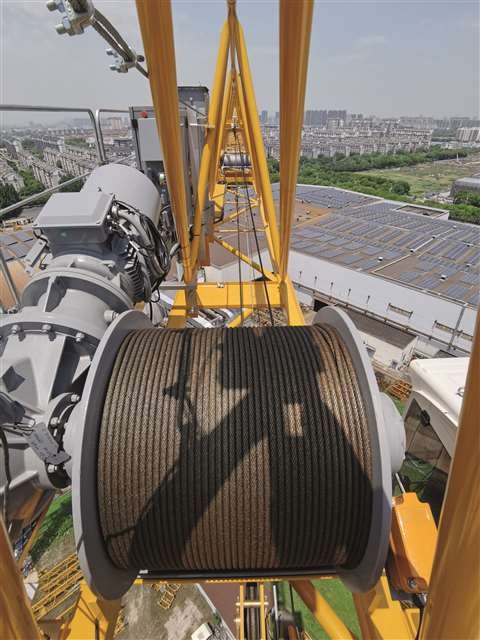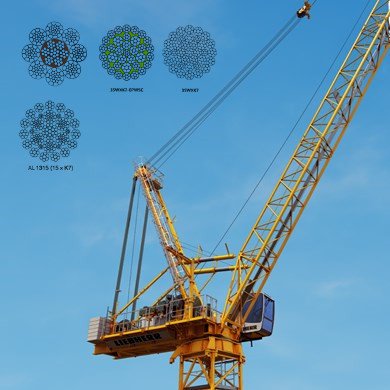Answer: Yes, galvanized wire rope can rust over time
This article will continue the discussion on galvanized wire rope from the following aspects.
Outline
Introduction to Galvanized Wire Rope
What is the difference between galvanized wire rope and stainless steel wire rope?
How does galvanization protect the wire rope from corrosion?
How can I maintain galvanized wire rope?
Can I re-galvanize wire rope if the coating wears off?
Introduction to Galvanized Wire Rope
Galvanized wire rope is a type of wire rope coated with a layer of zinc to protect it from corrosion and environmental wear. This protective coating makes galvanized wire rope ideal for use in harsh conditions where the rope is exposed to moisture, chemicals, or extreme weather. Galvanized wire ropes are widely used across various industries, including construction, marine, and mining, for their strength, durability, and longevity.
The galvanization process involves coating the wire rope with a layer of zinc to prevent rust and corrosion, significantly extending its lifespan compared to uncoated steel rope. There are two main types of galvanized wire rope: Electric Galvanized and Hot-Dip Galvanized. Each type has its specific applications and benefits.
Types of Galvanized Wire Rope
- Electric Galvanized Wire Rope (Electro-Galvanized):
- Process: In the electric galvanizing process, the wire rope is coated with zinc through an electroplating process. This involves immersing the wire in an electrolyte solution, with an electric current passing through it, causing zinc to adhere to the surface of the steel rope.
- Features:
- Thin Zinc Coating: The zinc layer is typically thinner than that of hot-dip galvanizing.
- Smooth Finish: Provides a smooth surface that reduces friction.
- Moderate Corrosion Resistance: The thinner zinc coating offers moderate protection against corrosion, making it suitable for environments with less severe exposure to corrosive elements.
- Cost-Effective: Electro-galvanizing is usually less expensive than hot-dip galvanizing.
- Applications: Ideal for indoor environments, low-corrosion areas, or light-duty applications like general construction, rigging, or where the rope will not be subjected to harsh weather conditions.
- Hot-Dip Galvanized Wire Rope:
- Process: In the hot-dip galvanizing process, the steel rope is dipped into a bath of molten zinc, resulting in a thicker, more robust coating. This method creates a strong bond between the zinc and the steel.
- Features:
- Thicker Zinc Coating: The galvanized layer is thicker and provides enhanced protection against corrosion.
- Superior Durability: Offers superior resistance to abrasion, rust, and corrosion, making it more suitable for tough and harsh environments.
- Better Performance in Harsh Environments: The thicker coating makes it ideal for marine, offshore, and other outdoor applications exposed to moisture, humidity, or chemicals.
- Longer Lifespan: The thicker coating results in a longer lifespan for the wire rope, reducing the frequency of maintenance and replacement.
- Applications: Commonly used in outdoor environments, such as marine and offshore applications, construction, mining, and agriculture, where the rope is exposed to extreme weather, moisture, or corrosive elements.
Benefits of Galvanized Wire Rope
- Enhanced Corrosion Resistance: Both electric and hot-dip galvanized wire ropes are highly resistant to rust and corrosion, though hot-dip galvanized ropes offer superior protection for harsh environments.
- Improved Durability: Galvanized wire ropes are more durable and have a longer lifespan compared to uncoated ropes.
- Cost-Effective: While galvanized ropes may have a higher initial cost, their extended lifespan and reduced maintenance requirements make them a cost-effective choice in the long term.
- Versatility: Galvanized wire ropes are used in a wide range of industries, including lifting, rigging, marine, construction, and mining, making them versatile for various applications.
Applications of Galvanized Wire Rope
- Marine and Offshore: Galvanized wire rope, particularly hot-dip galvanized, is commonly used in ship rigging, mooring lines, cranes, and lifting operations, where exposure to saltwater and harsh weather is frequent.
- Construction: Used in hoisting equipment, scaffolding, and rigging systems, where corrosion resistance is crucial due to exposure to outdoor elements.
- Mining: Essential for hauling materials and controlling equipment in mining environments, where ropes are exposed to heavy wear and environmental factors.
- Agriculture: Used in agricultural applications such as fencing, securing livestock, and supporting structures like trellises.
- Industrial Lifting and Rigging: Both types of galvanized ropes are used in lifting systems and rigging for heavy-duty industrial applications.
Conclusion
Galvanized wire ropes are an essential tool in many industries, offering superior strength and corrosion resistance. The choice between electric galvanized and hot-dip galvanized ropes depends on the specific environmental conditions and performance requirements of the application. Hot-dip galvanized ropes provide superior protection for harsh conditions, while electric galvanized ropes offer a cost-effective solution for lighter applications. Both types provide reliable, long-lasting performance, ensuring safety and efficiency in demanding environments.
What is the difference between galvanized wire rope and stainless steel wire rope?
Both galvanized wire rope and stainless steel wire rope are commonly used in a variety of industries for lifting, rigging, and other heavy-duty applications. However, they differ in material composition, corrosion resistance, cost, and other key factors. Here’s a breakdown of the differences:
1. Material Composition:
- Galvanized Wire Rope:
- Made from carbon steel (or alloy steel) that is coated with a layer of zinc through a process known as galvanization.
- The zinc coating is applied to protect the steel from rust and corrosion by acting as a sacrificial anode.
- Stainless Steel Wire Rope:
- Made from a steel alloy that contains a significant amount of chromium (at least 10.5%) along with other elements like nickel and molybdenum.
- The high chromium content forms a thin, protective oxide layer (passivation) on the surface of the wire, which prevents rust and corrosion.
2. Corrosion Resistance:
- Galvanized Wire Rope:
- Galvanized wire ropes are resistant to rust and corrosion, but the level of protection is dependent on the thickness of the zinc coating.
- Hot-dip galvanized ropes offer stronger corrosion resistance compared to electro-galvanized ropes, but they are still susceptible to corrosion in very harsh conditions, especially in marine environments or where chemicals are present.
- Over time, the zinc coating can degrade, especially in aggressive environments (saltwater, chemicals, etc.), which could lead to corrosion of the steel core.
- Stainless Steel Wire Rope:
- Stainless steel is highly resistant to rust, corrosion, and staining due to the presence of chromium, which forms a passive protective layer.
- Superior Corrosion Resistance: Stainless steel ropes can withstand harsh environments, including saltwater, extreme temperatures, and chemicals, without significant degradation.
- Ideal for long-term outdoor use, marine environments, and other applications where corrosion resistance is critical.
3. Strength and Durability:
- Galvanized Wire Rope:
- Generally has excellent strength and durability for most standard applications.
- The strength of galvanized wire rope is highly dependent on the quality of the steel and the thickness of the zinc coating.
- While durable, the rope may experience wear over time, especially if the zinc coating is damaged, which could result in rusting of the steel core.
- Stainless Steel Wire Rope:
- Stainless steel wire rope typically offers better overall strength and higher fatigue resistance compared to galvanized wire rope.
- It is more durable in applications that require long-term use in harsh conditions, as stainless steel maintains its strength and integrity even when exposed to extreme environments.
4. Cost:
- Galvanized Wire Rope:
- Less expensive than stainless steel wire rope due to the lower cost of production and the use of carbon steel as the base material.
- Galvanized wire ropes offer a good balance between cost and corrosion resistance, making them suitable for a variety of industries, especially when budget constraints are a consideration.
- Stainless Steel Wire Rope:
- More expensive than galvanized wire rope due to the higher cost of raw materials (stainless steel alloys).
- The higher cost is justified by the superior corrosion resistance and longer lifespan, making it a preferred option for specialized applications in harsh environments.
5. Appearance:
- Galvanized Wire Rope:
- Galvanized ropes typically have a shiny metallic appearance due to the zinc coating, which can dull over time as it wears away.
- The surface finish is smooth but may develop discoloration or slight oxidation over time.
- Stainless Steel Wire Rope:
- Stainless steel rope has a silvery-gray finish that is more consistent and durable than galvanized rope.
- The appearance remains relatively uniform and shiny even after prolonged exposure to harsh conditions.
6. Flexibility and Handling:
- Galvanized Wire Rope:
- Generally, galvanized wire rope tends to be slightly stiffer than stainless steel rope because of the zinc coating, which can impact flexibility.
- Over time, the coating may also wear down, affecting the handling and flexibility of the rope.
- Stainless Steel Wire Rope:
- Stainless steel wire rope is often more flexible than galvanized wire rope, making it easier to handle and install, especially in tight spaces or intricate systems.
- It retains its flexibility and strength over a longer period compared to galvanized ropes.
7. Applications:
- Galvanized Wire Rope:
- Commonly used in applications where corrosion resistance is important but extreme environmental conditions are not a concern, such as:
- Construction: For hoisting, rigging, and general lifting.
- Agriculture: For fencing and securing objects.
- Shipping/Transport: In less corrosive environments like warehouses or manufacturing sites.
- Less Suitable for Marine or Chemical Environments: It’s not ideal for environments exposed to harsh chemicals or saltwater for extended periods.
- Commonly used in applications where corrosion resistance is important but extreme environmental conditions are not a concern, such as:
- Stainless Steel Wire Rope:
- Preferred in demanding, long-term applications, including:
- Marine Environments: For mooring lines, ship rigging, and offshore applications.
- Food Processing: Where hygiene and resistance to corrosive agents are required.
- Medical and Pharmaceutical: Applications requiring strength and corrosion resistance.
- Heavy Industrial Use: In high-stress, high-corrosion environments like chemical plants, offshore oil rigs, and mining operations.
- Preferred in demanding, long-term applications, including:
Summary Table:
| Feature | Galvanized Wire Rope | Stainless Steel Wire Rope |
|---|---|---|
| Material Composition | Steel coated with zinc | Steel alloy with chromium (stainless steel) |
| Corrosion Resistance | Moderate (depends on galvanization) | Superior (excellent in harsh environments) |
| Cost | Less expensive | More expensive |
| Strength and Durability | Good, but can degrade over time | Higher strength and longer-lasting |
| Flexibility | Less flexible, more rigid | More flexible and easier to handle |
| Appearance | Shiny metallic, dulls over time | Consistent, shiny, and durable |
| Ideal Applications | Marine, offshore, industrial etc | Marine, offshore, industrial, medical |
Conclusion:
- Galvanized Wire Rope is a cost-effective option for applications where corrosion resistance is needed but extreme conditions (like marine or highly corrosive environments) are not a primary concern. It is well-suited for general use in construction, agriculture, and industrial applications.
- Stainless Steel Wire Rope is more expensive but offers superior corrosion resistance, durability, and strength, making it the best choice for harsh environments, including marine, offshore, and chemical industries.
Your choice between the two will depend on the specific environmental conditions, required lifespan, and budget constraints of your application.
How does galvanization protect the wire rope from corrosion?
Galvanization protects wire rope from corrosion through the application of a zinc coating to the steel wires, providing a barrier between the steel and the elements that cause rust. Here’s how galvanization works to protect the rope:
1. Barrier Protection:
- The zinc coating forms a physical barrier between the steel core of the rope and the external environment. This prevents moisture, oxygen, and other corrosive elements from coming into direct contact with the steel, which would otherwise lead to rusting.
- The zinc layer is impermeable to water and air, making it highly effective at preventing corrosion in normal atmospheric conditions.
2. Sacrificial Anode Effect:
- Zinc is more reactive than steel, which means that it will corrode before the steel beneath it does. This is known as the sacrificial anode effect.
- If the zinc coating is scratched or damaged, the exposed steel will still be protected because the zinc around the damage site will corrode first. The zinc “sacrifices” itself, protecting the underlying steel from rusting. This offers additional protection even in the event of minor physical damage to the coating.
3. Corrosion Resistance in Various Environments:
- Galvanized wire rope is designed to withstand moisture, rain, and humidity. It provides significant protection against corrosion in outdoor environments, especially when exposed to water or other elements like snow and salt.
- The thicker the zinc coating (as in hot-dip galvanization), the better the protection against more aggressive environmental factors such as saltwater, chemicals, and acids.
4. Resistance to Abrasion:
- The zinc coating is also somewhat durable against abrasion, offering a level of protection against mechanical wear that might otherwise expose the underlying steel to the environment. However, excessive friction or physical impact can damage the coating, which is why regular maintenance and inspections are recommended.
5. Self-Healing Property:
- In the case of minor damage (like a small scratch or cut), the galvanized coating has a self-healing property. Zinc will continue to corrode locally in place of the steel, providing protection even if there is no immediate repair to the damaged area.
- This means that small areas of damage to the zinc coating may not immediately compromise the entire rope’s corrosion resistance.
Summary of How Galvanization Protects Against Corrosion:
| Method of Protection | Explanation |
|---|---|
| Barrier Protection | Zinc creates a physical shield to prevent contact with moisture, oxygen, and corrosive elements. |
| Sacrificial Anode Effect | Zinc corrodes first, preventing the steel core from rusting if the coating is scratched. |
| Corrosion Resistance | Offers protection in outdoor and moderately corrosive environments, including rain, humidity, and mild saltwater exposure. |
| Abrasion Resistance | Zinc coating resists wear and tear, offering limited protection against frictional damage. |
| Self-Healing Property | Minor damage to the coating is mitigated as zinc continues to corrode, preventing damage to the steel underneath. |
Conclusion:
Galvanization protects wire rope by providing a dual mechanism of barrier protection and sacrificial corrosion prevention, ensuring the steel core remains protected from rust and degradation. The zinc coating acts as a first line of defense, making galvanized wire rope highly suitable for general outdoor use, moderate corrosion environments, and applications where long-term durability is needed. However, it’s important to regularly inspect galvanized wire rope for signs of wear or damage, as the protective coating can degrade over time, especially in harsher conditions.
How can I maintain galvanized wire rope?
Maintaining galvanized wire rope is crucial to extend its lifespan and ensure it performs safely and efficiently over time. Proper care prevents corrosion, abrasion, and wear, which can significantly affect the rope’s strength and functionality. Here are the key steps to maintaining galvanized wire rope:
1. Regular Inspections
Inspecting the wire rope is one of the most important aspects of maintenance. Regular checks help you detect early signs of wear, damage, or corrosion.
- Frequency of Inspections:
- For heavy-duty or critical applications (e.g., cranes, hoists, and winches), inspect the rope at least once a month.
- For less demanding applications, inspect the rope every 3-6 months.
- Check for the Following:
- Corrosion: Look for areas where the zinc coating has worn off, or the rope has started to rust. Corrosion can also occur inside the rope, so check for any signs of fraying or weakness in the strands.
- Fraying or Broken Wires: Look for strands that are broken or worn down, especially in high-friction areas. This indicates excessive wear or load.
- Kinks or Deformations: Any twists, kinks, or bends in the rope could weaken its structure and lead to failure.
- Wear on Sheaves or Drums: Ensure that the rope isn’t experiencing excessive friction from pulleys, sheaves, or drums. This can lead to uneven wear on the rope.
2. Cleaning
Cleaning the rope helps remove dirt, grease, salt, and other contaminants that can damage the zinc coating and promote rust.
- How to Clean:
- Dry Cleaning: Brush off any loose dirt, dust, or debris using a stiff brush.
- Wet Cleaning: Wash the rope with a mild detergent solution and water. Avoid using harsh chemicals, which can damage the galvanized coating. A soft cloth or sponge can help scrub off grime.
- Salt Removal: If the rope has been exposed to saltwater, it’s crucial to wash it with fresh water to remove the salt, as salt can accelerate corrosion.
3. Lubrication
Lubricating galvanized wire rope helps protect it from friction, rust, and wear. Lubricants create a protective film over the rope, reducing the contact of the wire with moisture and contaminants.
- Lubrication Options:
- Rust Inhibitors: Use a rust-inhibiting oil or lubricant designed for galvanized steel or wire rope. These products help prevent corrosion and provide a layer of protection.
- Graphite or Oil-Based Lubricants: These lubricants are often used in more demanding conditions where the rope undergoes frequent movement. They help reduce wear and friction.
- How to Apply:
- Apply lubricant evenly across the length of the rope, focusing on the strands and areas of high wear.
- Ensure that lubricant penetrates deep into the rope to protect against internal rust.
4. Protecting Against Abrasion
Excessive friction and abrasion can damage the galvanized coating, leading to premature corrosion.
- Use in Proper Applications: Ensure that the wire rope is used within the appropriate load and tension limits for its size and material. Overloading can increase friction, leading to wear.
- Proper Handling: Avoid dragging the rope over rough surfaces. When installing or removing the rope, handle it carefully to prevent damage.
- Smooth Sheaves and Drums: Ensure that the pulleys, sheaves, and drums that the rope runs through are in good condition and free of sharp edges or rough spots. These can cause excessive wear on the rope.
- Use of Guides or Sleeves: Consider using guides or sleeves to protect the rope from rough or abrasive surfaces when appropriate.
5. Avoiding Chemical Exposure
Harsh chemicals can degrade the galvanized coating, so it’s important to minimize exposure to them.
- Avoid Contact with Acid or Alkali: If the rope is used in environments where it may come into contact with chemicals, be sure to clean it promptly and regularly. Some chemicals, especially acids and strong bases, can eat away at the zinc coating.
- Preventive Measures: If possible, use protective covers or coatings to shield the rope from harmful chemicals in industrial or chemical environments.
6. Protecting from Extreme Weather
Weather conditions like extreme heat, moisture, and UV rays can degrade galvanized wire rope over time.
- UV Protection: Although galvanized wire rope is relatively resistant to UV damage, prolonged exposure to sunlight can degrade the coating. If possible, store the rope in a sheltered area or cover it when not in use.
- Freezing Temperatures: Cold weather and freezing conditions can cause moisture to freeze on the rope, potentially causing it to expand and damage the zinc coating. Make sure the rope is dry before storing it in cold environments.
- Moisture Control: If you’re using the rope outdoors, ensure it doesn’t stay wet for long periods, as moisture can promote rusting, especially in the presence of contaminants like salt.
7. Re-coating or Replacing the Rope
Over time, the zinc coating on galvanized wire rope can wear off, especially in areas exposed to heavy abrasion or harsh environmental conditions. If the coating is heavily worn or damaged, you may need to either re-coat the rope or replace it entirely.
- Re-coating (if possible): Re-galvanizing the wire rope may be an option, although it can be difficult due to the rope’s structure. This process involves stripping off the old zinc coating and applying a new layer. However, this is typically more expensive and less practical than replacing the rope entirely.
- Replacement: If the rope is showing signs of severe wear, corrosion, or damage that can’t be repaired, it’s safer to replace it to avoid potential failure.
8. Storage
When the wire rope is not in use, proper storage is essential to prevent damage from weather, moisture, or environmental contaminants.
- Store Indoors: If possible, store galvanized wire rope indoors in a dry and cool area to prevent exposure to moisture, extreme temperatures, or corrosive chemicals.
- Covering: If the rope must be stored outdoors, cover it with a waterproof, breathable tarp or cover to protect it from the elements while allowing air circulation.
9. Handling and Installation
Improper installation can cause significant damage to the galvanized wire rope and reduce its lifespan.
- Proper Installation Techniques:
- Avoid sharp bends or twists in the rope, as these can compromise its strength and cause premature wear.
- Use the appropriate drums, sheaves, and pulleys to prevent overloading and excessive wear.
- When spooling or winding the rope, ensure it’s done evenly to prevent uneven wear and potential damage.
Summary of Maintenance Tips for Galvanized Wire Rope:
| Maintenance Task | Recommended Action |
|---|---|
| Regular Inspections | Inspect for corrosion, fraying, and wear monthly or more frequently for critical applications. |
| Cleaning | Clean with mild detergent and water; remove saltwater after use in marine environments. |
| Lubrication | Use rust inhibitors or oil-based lubricants to protect against corrosion and reduce friction. |
| Protection from Abrasion | Minimize contact with rough surfaces; use smooth sheaves and guides. |
| Chemical Protection | Avoid exposure to acids, alkalis, and harsh chemicals; clean after exposure. |
| Storage | Store indoors, or cover when stored outdoors to protect from moisture and UV. |
| Re-coating or Replacement | Re-coat if necessary; replace the rope if the coating is severely worn or damaged. |
| Proper Handling and Installation | Avoid sharp bends or overloading; use appropriate sheaves and drums. |
Conclusion:
Regular maintenance of galvanized wire rope, including inspections, cleaning, lubrication, and protecting it from abrasion, moisture, and chemicals, will greatly extend its lifespan. Proper storage and handling are also essential to avoid unnecessary wear. By taking these steps, you can ensure the rope remains strong and reliable for as long as possible, minimizing the risk of failure and ensuring safe operation in demanding applications.
Can I re-galvanize wire rope if the coating wears off?
Yes, re-galvanizing a wire rope is technically possible, but it comes with some challenges and considerations. Re-galvanizing involves stripping off the old galvanized coating and applying a new layer of zinc to the wire rope. However, this process can be more complex than simply re-coating other types of steel products due to the rope’s structure and its use in demanding environments.
Challenges of Re-Galvanizing Wire Rope:
- Complex Structure:
- Wire rope is made up of many small individual strands, and the process of galvanizing these small components can be difficult. The heat and the chemical process involved in hot-dip galvanizing may affect the internal structure of the rope.
- If not done properly, the process could lead to damage or changes in the mechanical properties of the rope (like reducing its strength or flexibility), which may compromise its performance.
- Heat Sensitivity:
- Hot-dip galvanization involves dipping the rope into molten zinc at very high temperatures (around 450°C or 850°F). This heat can affect the rope’s internal structure, leading to softening of the wires, especially if the rope has already been subjected to heavy loads and wear. This can reduce the rope’s overall strength.
- Coating Integrity:
- If the rope has been used extensively, its internal wires may have already experienced some damage, corrosion, or fatigue. Simply re-coating the rope might not restore its original strength if the wire itself is compromised.
- Cost and Practicality:
- Re-galvanizing wire rope can be more expensive and impractical than simply replacing the rope with a new one. The costs associated with stripping off the old coating, preparing the rope, and reapplying the galvanizing layer can add up, and in many cases, it may be more cost-effective to replace the rope.
Alternative Approaches:
- Re-Coating with Zinc Spray or Cold Galvanizing:
- If the coating is only slightly worn and the rope is still structurally sound, a cold galvanizing spray or zinc-rich paint may be a viable alternative. This involves applying a layer of zinc coating without the need for high heat. While not as durable as hot-dip galvanization, this method can provide temporary protection and is easier to apply than re-galvanizing.
- Routine Inspections and Maintenance:
- Regular inspections can help identify areas where the coating has worn off and address localized corrosion with spot treatments, such as cleaning and re-coating the affected areas. For ropes that are still in good condition but have minor coating damage, this can be an effective way to extend their life.
- Replacing the Wire Rope:
- In many cases, replacing the wire rope entirely may be the best option, especially if the rope has been heavily used, has significant internal wear, or is exposed to extreme environments. A new galvanized wire rope, or even a stainless steel wire rope (for harsh environments), will provide better long-term performance.
When to Consider Re-Galvanizing:
- Mild Wear: If the rope is still in good condition overall but has suffered minor damage to the coating in localized areas (due to abrasion or wear), you might consider re-galvanizing to restore the coating’s integrity.
- Critical Applications: For applications where the rope is used in high-stress or safety-critical environments, maintaining the full protective coating is vital. In this case, re-galvanizing may be necessary to restore the rope’s original performance.
Summary of Considerations for Re-Galvanizing Wire Rope:
| Factor | Consideration |
|---|---|
| Structural Integrity | Re-galvanizing can affect the rope’s strength and flexibility due to heat exposure. |
| Cost and Practicality | Re-galvanizing can be expensive and may not be cost-effective compared to replacing the rope. |
| Coating Durability | Cold galvanizing (zinc spray) may be a practical alternative for minor damage, but it’s not as durable as hot-dip galvanization. |
| Wear and Damage | If the rope has internal wear or significant damage, re-galvanizing might not restore its strength. |
| Alternatives | Spot treatments, routine inspections, and possibly replacing the rope may be better options. |
Conclusion:
Re-galvanizing wire rope is possible but often not the most practical or cost-effective solution. The process can affect the rope’s strength, and it may not be suitable for ropes that have undergone extensive wear or damage. For ropes with minor coating damage, alternatives such as cold galvanizing or zinc sprays could be a viable solution. In many cases, replacing the rope entirely might be the most effective way to ensure safety and performance, especially in demanding environments.

